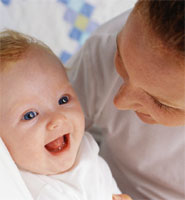Increased government support for families has coincided with a rise in births among women who left school at 16 compared to those who stayed in education after the age of 18.
This is the finding of new research by Sarah Smith and colleagues in the Centre for Market and Public Organisation at the University. According to the research, the probability of having a baby increased by 1.2 percentage points among women who left school at 16, compared to those who stayed in education after the age of 18. This equates to nearly 45,000 additional births.
The UK birth rate has increased steadily since 2001 and now stands at an average of 1.9 births per woman, the highest level since 1974. Some of this increase is attributable to the growing proportion of births to women born outside the UK, who typically have higher birth rates. But there has also been an increase in the birth rate among women born in the UK: from 1.68 in 2004 to 1.79 in 2007.
The study suggests that changes to government support for families has made it economically more attractive to have children. In 1999, the government implemented a set of reforms to help low-income families with children. Between 1999 and 2003, government spending per child on Working Families’ Tax Credit (WFTC) and Income Support (IS) rose by more than 50% in real terms, a change that was unprecedented over a 30-year period. Most of the additional spending was targeted at low-income households.
Smith and her colleagues examine whether these reforms have had an effect on childbearing. They compare births before and after the changes were introduced, exploiting the fact that the reforms were targeted at low-income households to define a ‘treatment group’ who were affected by the reform and a ‘control group’ who were unaffected. The aim with the control group is to take account of any other changes in births that might have occurred over the period.
The analysis takes its data from the Family Expenditure Survey (from the financial year 1990/2001 until 2003/04) and the Family Resources Survey (from 1995/96 until 2003/04). Both gather a wide range of socio-economic and demographic information on over 7,000 and 20,000 households respectively each year.
The study finds consistent evidence that the increase in government support coincided with a rise in births among those who left school at 16 compared to those who stayed in education after the age of 18.
In line with studies in other countries, the researchers find that the fertility response varies by birth order and is strongest for first births. The decision whether to have children (or at least when to begin having them) appears to be more susceptible to financial incentives than the decision over how many to have, once childbearing has begun. The study finds evidence that the age at first birth falls among younger women, suggesting that these women are bringing forward their childbearing.
As a final test of whether the reforms had an effect on births, the researchers looked for additional supporting evidence in changes in contraceptive use among the group affected by the reform.
Using data from the 1998 and 2002 UK General Household Surveys, which contain information on the use of contraception, they show that there was an increase in the proportion of women in the age-16 group reporting that they were not using contraception because they were trying to get – or already were – pregnant.
